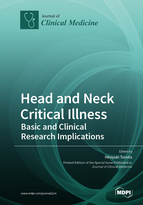Head and Neck Critical Illness: Basic and Clinical Research Implications
A special issue of Journal of Clinical Medicine (ISSN 2077-0383). This special issue belongs to the section "Oncology".
Deadline for manuscript submissions: closed (31 December 2018) | Viewed by 102902
Special Issue Editor
Interests: pathology; tumor microenvironment; carcinogenesis; stem cell; mouse models
Special Issues, Collections and Topics in MDPI journals
Special Issue Information
Dear Colleagues,
There are various malignant tumors in the head and neck area, including oral cavity, pharynx, sinonasal cavity, and salivary glands. Squamous cell carcinoma is the most common cancer among head and neck cancers. In salivary glands, there are many types of malignancies that can develop, such as malignant lymphoma, adenoid cystic carcinoma, adenocarcinoma, and mesenchymal tumors. In a clinical setting, imaging, such as Computed Tomography (CT) and Magnetic Resonance Imaging (MRI), is very important in terms of the prediction of histological type and evaluation of the extent of invasion of adjacent structures. In basic research, there are few animal models in head and neck malignancies. In this Special Issue, we broadly discuss basic and clinical research in head and neck malignancies.
Prof. Dr. Hiroyuki TomitaGuest Editor
Manuscript Submission Information
Manuscripts should be submitted online at www.mdpi.com by registering and logging in to this website. Once you are registered, click here to go to the submission form. Manuscripts can be submitted until the deadline. All submissions that pass pre-check are peer-reviewed. Accepted papers will be published continuously in the journal (as soon as accepted) and will be listed together on the special issue website. Research articles, review articles as well as short communications are invited. For planned papers, a title and short abstract (about 100 words) can be sent to the Editorial Office for announcement on this website.
Submitted manuscripts should not have been published previously, nor be under consideration for publication elsewhere (except conference proceedings papers). All manuscripts are thoroughly refereed through a single-blind peer-review process. A guide for authors and other relevant information for submission of manuscripts is available on the Instructions for Authors page. Journal of Clinical Medicine is an international peer-reviewed open access semimonthly journal published by MDPI.
Please visit the Instructions for Authors page before submitting a manuscript. The Article Processing Charge (APC) for publication in this open access journal is 2600 CHF (Swiss Francs). Submitted papers should be well formatted and use good English. Authors may use MDPI's English editing service prior to publication or during author revisions.
Keywords
- Malignancy
- Head and neck
- Cancer
- Imaging
- Carcinoma







